Sringeri
Sringeri also called Sri Kshetra Shringeri is a hill town and Taluk headquarters located in Chikkamagaluru district in the Indian state of Karnataka. It is the site of the first maṭha (Dakshinamnaya Sringeri Sharada Peetham) established by Adi Shankara, Hindu theologian and exponent of the Advaita Vedanta philosophy, in the 8th century CE. It is located on the banks of the river Tungā.
Sri Kshetra Sringeri | |
|---|---|
Temple town | |
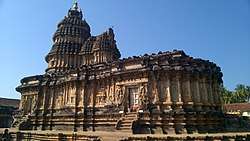 Sri Vidyashankara temple (1342 AD) at Sringeri | |
 Sri Kshetra Sringeri | |
| Coordinates: 13.42°N 75.25°E | |
| Country | |
| State | Karnataka |
| District | Chikkamangaluru |
| Region | Malenadu |
| Government | |
| • MLA | T D Rajegowda (Indian National Congress) |
| Elevation | 672 m (2,205 ft) |
| Population (2011) | |
| • Total | 36,539
Male- 18,030 Female- 18,509 |
| Languages | |
| • Official | Kannada |
| • Regional | Kannada. |
| Time zone | UTC+5:30 (IST) |
| PIN | 577139 |
| Telephone code | 08265 |
| Vehicle registration | KA-18 |
Origin of the name
The name Sringeri is derived from Rishyashringa-giri, a nearby hill that is believed to have contained the heritage of Rishi Vibhandaka and his son Rishyashringa. Rishyashringa appears in an episode in the Bala-Kanda of the Ramayana where a story, narrated by Vasishtha, relates how he brought rains to the drought-stricken kingdom of Romapada.[1]
Legend
According to legend, Adi Shankaracharya is said to have selected the site as the place to stay and teach his disciples, because when he was walking by the Tunga river, he saw a cobra with a raised hood, providing shelter from the hot sun, to a frog undergoing labour. Impressed with the place where natural enemies had gone beyond their instincts, he stayed here for twelve years. Adi Shankaracharya also established mathas in the northern (at Jyotirmath, near Badrinath), eastern (at Puri) and western (at Dwaraka) quarters of India.
Geography and climate
Sringeri is located at 13.42°N 75.25°E.[2] It has an average elevation of 672 metres (2204 ft). The average annual temperature is 23.5 °C, with the highest temperatures reaching 32 °C in April and lowest temperatures of 16 °C in winter months (December-January). There is significant rainfall (annual average of 380 cm), mostly during the months of June, July and August.
Demographics
As of the 2011 India census,[3] Sringeri had a population of 36,539. Males constitute 49% of the population and females 51%. Sringeri has an average literacy rate of 86.12%, higher than the national average of 74.04%: male literacy is 90.45%, and female literacy is 81.91%. In Sringeri, 8.5% of the population is under 6 years of age.
Temples in Sringeri
Sringeri is home to a number of historic temples. Of these, Sri Sharadamba temple, Sri Vidyashankara temple and Sri Malahanikareshwara temple are prominent.
Sri Sharadamba temple
The ancient temple of Sri Sharada, the presiding deity of Sringeri has a glorious history that begins with the setting up of the Dakshinamnaya Peetham by Sri Shankara Bhagavatpada. Originally it was an unpretentious shrine with the idol of Sharada made of sandalwood, installed over the Sri Chakra that Sri Adi Shankara carved on a rock. Subsequently, Sri Bharati Krishna Tirtha and Sri Vidyaranya had a temple built in the Kerala style, with timber and tiled roof. Sri Bharati Krishna Tirtha substituted the sandalwood idol with the present golden idol.
Sri Sacchidananda Shivabhinava Nrisimha Bharati raised the present structure in granite with polished granite walling around the sanctum and Sri Chandrasekhara Bharati consecrated the new temple in May 1916. Sri Abhinava Vidyatirtha made several improvements in the temple. The Mahamandapam has large stone pillars exquisitely carved with deities like Durga, Raja Rajeshwari, Dwarapalakas and Devis which are all sculpted according to the Shilpa Sastras practised in Tamilnadu.
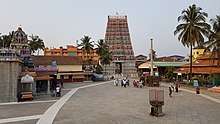
Construction of the 127 feet tall Rajagopuram entrance was completed in 2014. Its Kumbhabhishekam (grand inauguration) was performed by Sri Bharati Tirtha Mahaswamiji on 8 June 2014, the day of Jaya Samvatsariya Jyeshtha Shuddha Dashami.
In addition to Sri Sharadamba temple, the following temples and shrines are within the temple complex:
- Sri Thorana Ganapathy shrine
- Sri Adi Shankaracharya temple
- Sri Shakthi Ganapathy shrine
- Sri Kodandaramaswamy shrine
- Sri Malayala Brahma shrine
- Sri Sureshwaracharya Samadhi shrine
- Sri Vageeswari Vidyaranya shrine
- Sri Janardhanaswamy shrine
- Sri Anjaneya shrine
- Sri Garuda shrine
- Sri Balasubrahmanyaswamy shrine
Sri Vidyashankara temple
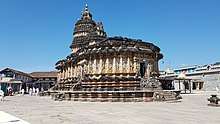
The Vidyashankara temple was built in the year 1338 A.D., in commemoration of the pontiff Sri Vidyashankara, by Sri Vidyaranya, patron-saint of Harihara and Bukka, the brothers who founded the Vijayanagara empire. Inscriptions in the temple record contributions made by several Vijayanagara emperors but the temple was probably built on an earlier Hoysala site as it combines Hoysala (Chalukya) and Vijayanagara (Dravida) architectural features. It is built entirely of stone and stands on a high plinth, more or less a rectangle with apisidal east-west ends. On the western side is the garbhagriha, with Vidya Ganapati on one side and Durga on the other side. On the other three sides of the garbhagriha are shrines to Brahma, Vishnu and Maheshwara with their consorts.
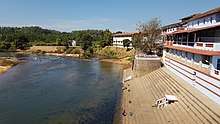
In the eastern half of the structure is a mantapa with twelve pillars (popularly known as rashi stambhas), marked by the twelve signs of the zodiac. The rays of the sun fall on each of them in the order of the twelve solar months. On the floor is a large circle, marked with converging lines to indicate the direction of the shadows. The central ceiling is an exquisite piece of workmanship with lotus and pecking parrots. The vimana over the garbhagriha rises with shikhara, mahapadma and stupa. The rest of the roof is made up of sloping channeled slab. The basement is elaborately sculpted with animals, puranic stories, Shiva, Vishnu, Dashavatara, Kali, Shanmukha and so on. Other intricate features include chains of stone rings and growling lions with stone balls inside the faces, which can be rotated. The temple is under the care of the Archaeological Survey of India.[4][5][6][7]
Vidyatirtha Rathotsava is celebrated on a grand scale during kartika shukla paksha. The festival spans for seven days from tritiya to navami. On the saptami day Jagadguru Bharathi Teertha Mahaswamiji[8] performs special puja. The aradhana of Sri Vidya Shankara is performed on shasti, saptami and ashtami.
Sri Malahanikareshvara temple

Malahanikaresvara means destroyer of the impurities of the soul. This serene temple is located at the centre of the Sringeri town, atop a small hill, and can be reached by a flight of about 170 steps. The temple structure is a fine piece of architecture in stone, consisting of navaranga, antarala and garbhagrha. The ceiling has a lotus bud carving. The deities inside the temple include Malahanikaresvara, Bhavani, Chandikeshwara, Durga and Sthambha Ganapati. The linga is said have been worshiped by Sage Vibhandaka, son of Sage Kashyapa. After many years of penance, Vibhandaka had the vision of the Lord and merged into the Linga. The Sthanbha Ganapati was created in stone by Sri Ahinava Narasimha Bharati (1599 – 1622), the 24th Jagadguru, by drawing a figure of Ganesha with a piece of turmeric on one of the front pillars. Outside the temple, there are small shrines of Meenakshi Sachidanandeshvara, Kshetra Palaka and Bindu Madhava.
On Mahashivaratri, the Jagadguru performs special Puja to the Lord. On Kartika Poornima day, Laksha Deepothsavam is celebrated on a grand scale in the presence of the Jagadguru.
Temples of guardian deities
Sri Adi Shankara had constructed four temples on the four sides of the Sringeri village.
- Kala Bhairava Temple in the East
- Kere Anjaneya Temple in the West
- Kalikamba Temple in the North
- Durgamba Temple in the South
Sri Parshwanath Swamy Basadi
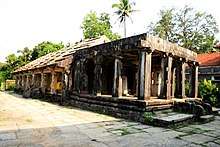
Sri Parshwanath Basadi (Digambar Jain Temple) is situated in the heart of Sringeri Town. This basadi was built in the memory of Mari Setty whose origin goes to one Vijayanagara Shanthi Shetty of Nidugodu village near Belur. The date of construction comes to about 1150 A.D. The main temple is 50 feet long and 30 feet wide. Completely built of stone it has a sloped roof. The Basadi consists of Garbhagriha, Sukhanasi, Navaranga, Mukha Mandapa and Pradakshina Patha.
In the Garbhagriha, there is the idol of Sri Parshwanatha Swamy, the presiding deity made of black stone. It is one foot high and on its base, the words Srimathparisanathaya Namaha are inscribed. Generally a single cobra holds its hood over the Lord’s head. But here, the specialty is that a pair of cobras intertwined hold their seven hoods like an umbrella. Hence this deity is known as Jodi Parshwanatha Swamy.
In the sukhanasi the idol of Goddess Padmavati is kept. It is about nine inches in height and is made of black stone. Besides this there are also Jina images of marble, sphatika, black stone and the bronze images of 24 tirthankaras in the Gandhakuti, as well as idols of Brahma, Saraswathi, and Ganadharas.[9]
Sringeri Sharada Peetha
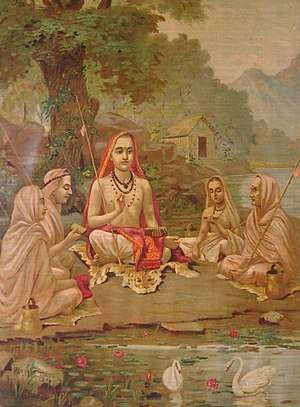
The Sringeri Sharada Peetha or Matha is located South of the Sri Sharadamba temple, across the Tunga river, in Narasimha Vana. A foot bridge, called Vidyatheertha Setu connects the two sides. The Sringeri Sharada Peetha is also called Dakshinamnaya Sringeri Sharada peetam. It is one of the four Hindu Advaita maths established by Adi Shankaracharya. Following the tradition initiated by Adi Shankaracharya, the maţha is in charge of the Yajur Veda (the Krishna (Black) Yajurveda is more prevalent in South India, over which the maţha has authority in the Smarta tradition).The head of the matha is called Jagadguru (teacher to the world) and also carries the Shankaracharya name as a title. The present Sringeri Shankaracharya Shri Bharati Tirtha Swamiji has nominated Jagadguru Vidhushekhara Bharathi Mahaswami as his successor.
Nearby places of interest
There are several other historic temples and places of natural beauty around Sringeri.
Sri Rishyashringeshwara temple
Surrounded by lush greenery, Sri Rishyashrungeshwara temple is located in Kigga village on the banks of Nandini river, a tributary of Tunga. Built during Vijayanagara period, the temple houses a linga of a unique shape, with three protuberances resembling horns. There is a big Nandi statue in front of the temple. It is said that sage Rishyasringa performed penance here. It is believed that the worship of the linga averts famine in the land up to a distance of 12 yojanas (100 miles). The Rathotsavam of the temple is conducted in the month of Chaitra (March/April).
Kigga is 9 km from Sringeri, connected by bus and cabs. Kigga is also the exit point for Narasimha Parvata trekking which starts from Agumbe. Sirimane Falls is about 5 km from Kigga situated on Narasimha Parvata trekking route.
Sirimane falls
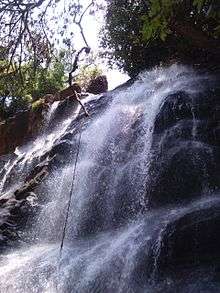
Sirimane falls is situated at a distance of 12 km from Sringeri. Visitors can visit the place by two wheelers and small vehicles like Car, Jeep and Suvs. No public transport is available till Sirimane falls. However limited number of buses from Sringeri town till Kigga are available. Kigga is located 5 km away from the falls. One can Hire vehicles from Sringeri to visit Sirimane falls.
Kundadri hills
.jpg)
Kundadri hills is another must visit place near Sringeri. Situated at a distance of approximately 30km from Sringeri, Kundadri is a hill (826 mt) with dense forests in the Western Ghats. An ancient Jain temple is located on the top of this hill. This is a very beautiful place to visit during evening times to enjoy the cold breeze and the sight of colorful sunset.
Hanumanagundi falls
Hanumanagundi falls also known as Soothanabbi falls is located on the way to Horanadu Via Kudremukh. Distance between Sringeri and the waterfalls is 36 km. Waterfalls lies inside Kudremukh National forest which is famous for Shola Forests. Gangamoola the birthplace of Tunga, Bhadra and Netravati rivers also lies in this region.ITS CLOSED NOW DUE GOVERNMENT REGULATIONS
How to reach
The nearest airport is at Mangalore, at a distance of 105 kilometers in South-West direction by road via Karkala. The town of Udupi, connected to Mumbai via Konkan Railway, is at distance of 80 km by road in the Western direction via Hebri and Agumbe. Shimoga (Shivamogga) is 105 km by road in North-East direction. Chikmagalur is at a distance of 86 km by road in Eastern direction, connected to Bengaluru through road and rail line via Kadur. Several travel agencies including KSRTC, SRS and Sugama operate AC and non-AC luxury buses between Sringeri and Bengaluru, a distance of 320 km.
Where to stay
Though Sringeri is a small town, there are a number of options for accommodation. The Sringeri Mutt runs several guest houses located near the Sri Sharadamba temple. There are also many private lodges, most of them on the Bharthi Street and Harihara Street, and one hotel (Sharada Comforts) near Shankaracharya Circle.
Best time to Visit
Since Sringeri is situated in the Malnad region spanning the Western Ghats, the best time to visit is between October and March.
See also
References
- "The legend of Rishyasringa". Sringeri Sharada Peeta. Retrieved 7 November 2006.
- Falling Rain Genomics, Inc - Sringeri
- "Census of India 2001: Data from the 2001 Census, including cities, villages and towns (Provisional)". Census Commission of India. Archived from the original on 16 June 2004. Retrieved 1 November 2008.
- http://www.sringeri.net/temples/sri-vidyashankara%7Caccessdate= 2015-03-15|
- "Sri Vidyashankara Temple". Sringeri Sharada Peeta. Retrieved 7 November 2006.
- "Zodiacal pillars of Sringeri" (PDF). Current Science. Indian Academy of Sciences. Archived from the original (PDF) on 7 October 2007. Retrieved 25 March 2006.
- "Vidyashankara Temple". Indiantemples.com. Retrieved 7 November 2006.
- http://www.sringeri.net/jagadgurus/sri-bharati-tirtha-mahaswamiji
- http://www.jainheritagecentres.com/jainism-in-india/karnataka/sringeri/
External links
| Wikimedia Commons has media related to shringeri. |

- A Photo Essay of Sringeri
- Some offbeat photos of Sringeri
- Shankara Sringeri
- Sri Parshwanath Swamy Digambar Jain Temple